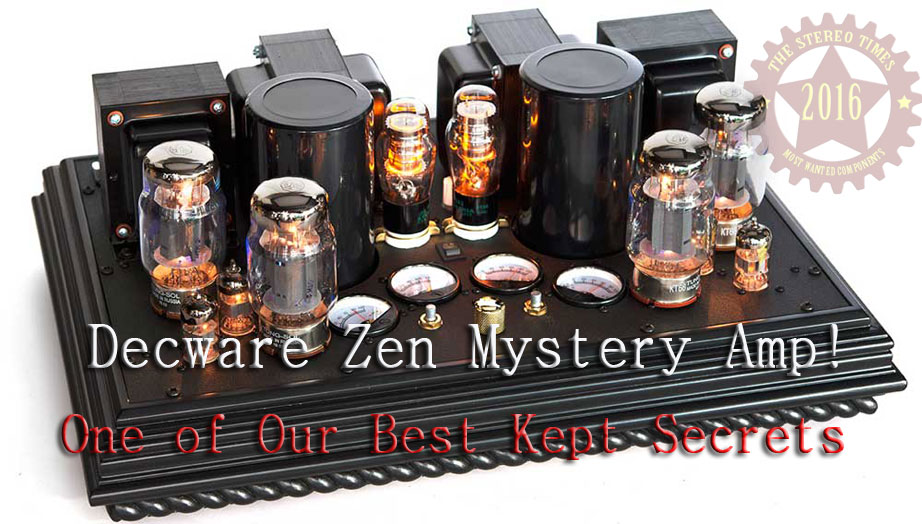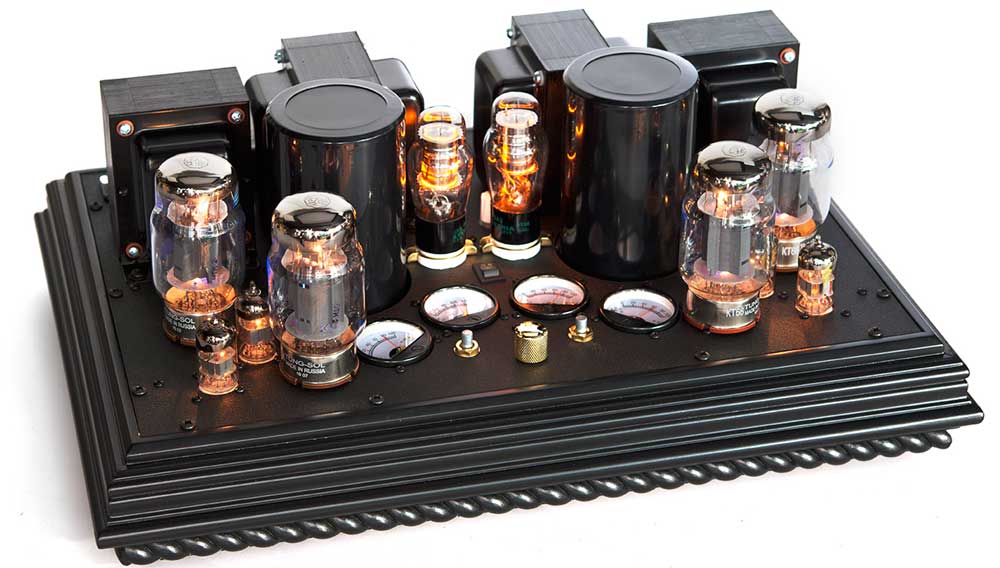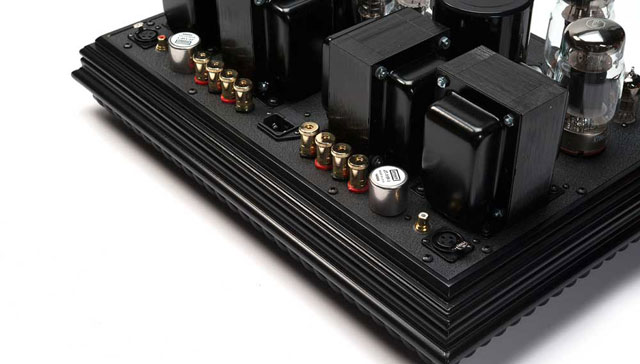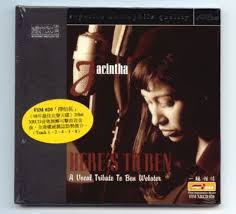Decware Zen Mystery amplifier

 I was having an animated conversation with my wife and one of my audio buddies, Derek Kim, about the amplifiers I’ve reviewed. He was very impressed with the sound quality he has heard but he sure wasn’t happy about the prices. He said “Why do they have to be so expensive? Isn’t there an amplifier that sounds great but is easy on the pocket too?” He suggested that I try to find one that performs with reference quality but at a reasonable price. Unfortunately, the majority of reference caliber amplifiers do cost a lot of money. So I started to do some research, hoping to find an amplifier that didn’t cost an arm and a leg but performed like a winner. Was there such a product?
I was having an animated conversation with my wife and one of my audio buddies, Derek Kim, about the amplifiers I’ve reviewed. He was very impressed with the sound quality he has heard but he sure wasn’t happy about the prices. He said “Why do they have to be so expensive? Isn’t there an amplifier that sounds great but is easy on the pocket too?” He suggested that I try to find one that performs with reference quality but at a reasonable price. Unfortunately, the majority of reference caliber amplifiers do cost a lot of money. So I started to do some research, hoping to find an amplifier that didn’t cost an arm and a leg but performed like a winner. Was there such a product?
That’s when I came across the Zen Mystery Amplifier from Decware. I was thrilled to find out that this amplifier turned out to be a real gem. In fact, it may be one of the best-kept secrets in high-end audio. I was surprised that the ZMA costs only $5,695.00. Don’t get me wrong. It’s clearly a lot of money but in today’s astronomically priced world of audio it’s a safe bet to call this affordable. I wondered why I didn’t know about Decware. Who are these people? So I contacted Steve Deckert and expressed my interest in reviewing one of his amplifiers and he told me that he’d send the ZMA for review but it would take a couple of months to have the review sample ready. He told me he would need to fulfill his commitment to his client’s orders first and then he would build a ZMA for me to review.
Steve Deckert is the designer and founder of Decware. He’s a self-taught designer. He said; “He learned with a Harmon Kardon tube receiver back in the 80’s when he completely took it apart. He made a new wooden chassis, changed the layout, and reassembled all the old parts onto the new chassis. When completed, it was visually stunning… but a funny thing happened when he plugged it in: Smoke came out!” This started his long road to learning analog electronics. It took Deckert six to seven hours every night for a month before he actually got the amplifier to work, and some thirty years to actually feel really good about his work. Between him and his guys, they have now built over 6,000 amplifiers, all of them are still in service. He started Decware in the early 90’s doing commercial sound systems and building custom speaker cabinets. He also had a speaker repair shop where he made custom re-cone kits for obsolete speakers. During this time, as an audiophile, he taught himself how to build tube amplifiers to support his own audiophile habit.
Deckert is a perfectionist. For example, he spent over three years perfecting building and listening to almost four hundred variations of his favorite 2 watt SET amplifier. His speaker repair business was booming but one terrible morning he went into his cabinet shop and it was empty. The unthinkable had happened. Someone had pulled a truck up to the loading dock and taken everything. Literally, everything was gone. He was so mad that he wasn’t able to go back into the building for over a year. It seems that everything does happen for a reason. Now that he was out of the cabinet business, he decided to see if he could sell his 2 watt SET amplifier online. He made 25 SET amplifiers on the back porch and found himself back in the shop a year later manufacturing his 2 watt SET amplifiers. In essence, Decware was born. He outgrew his shop and moved the business to a larger building and changed the old shop into a small recording studio. Deckert hosted an open jam in his studio down by the Upper Peoria Lake every Thursday night for 11 years. He recorded many of these sessions and as a result has produced many audiophile recordings. Since those early days of Decware, the amplifier line has evolved to push the “fidelity vs. power curve” out to 40 watts with the ZMA. This journey has taken almost 20 years but Decware tube amplifiers are still hand-built in USA and are sold direct from the manufacturer only! This allows for his products to be sold at wholesale prices. Decware’s first 2 watt amplifier was called The Zen Triode. This was in 1996. (Yes: twenty years in business and counting). Deckert tells me that he sells his amplifiers at a low margin and no one’s making five figure salaries. Each and every amplifier is hand made at Decware, using special steel work from Chicago. The wood comes from North Carolina. The transformers come from California and are built to their proprietary specs. Impressively, all their amplifiers are point to point wired which takes a lot of time. Deckert states that he “simply could have made the amplifier with a circuit board, which would double his profit but he refused because it did not sound as good and would make a lifetime warranty impossible.”

The Zen Mystery Amp is a push pull tube amplifier based on an ultra-linear design. It’s a Class-A design, using two KT66s per side to produce a powerful 40 watts per channel with zero negative feedback. It’s an amplifier with a 20 POS stepped attenuator. The ZMA is equipped with a pair of Russian military grade 10,000 hour 6N23P with gold grids. The 6N23P input tubes can be swapped for 6N1Ps or 6922s, but Deckert says the 6N23P is his favorites. A pair of OA3 tubes is used for the voltage regulator and he chose to use a fast recovery solid-state rectifier instead of a tube rectifier. The ZMA came directly from their reference Zen TORII monoblocks. Deckert says he wanted a ZMA with similar performance, but in a single chassis and at a reduced cost. He achieved this by building two mono amps in a single chassis, and eliminating fancy transformer covers, reducing power a bit, using smaller bias meters and making balanced XLR inputs optional. It was possible to maintain high quality and design using the internal parts used in the Zen TORII monoblocks. The ZMA is actually two mono amplifiers that are laid out symmetrically in a mirror image in a single chassis.

Only the IEC connector, power switch, and the master volume control are common to both channels. The power supply is the heart and soul of the amplifier and Deckert is very serious about his power supply design. The ZMA’s power supply is superbly designed with capacitors totaling a massive 4500 micro-farads. Yes, that’s about 50 times more than normal for a typical tube amplifier of this size. Having an enormous power supply with capacitors so large makes it possible to eliminate the dropping resistors that feed the input stage. This was Deckert’s personal goal. He wanted this the first tube amplifier power supply in the world that doesn’t use a choke or any current robbing resistors to supply both input and output stages of the amplifier.
The Zen Mystery amplifier was delivered nicely packed in a military grade waterproof padded flight case with wheels. They say don’t judge a book by its cover, but I was impressed by their meticulous detail in packaging. The tubes were nicely marked corresponding to the amplifier for a quick set up. The ZMA design is an elegantly attractive with a rich finished. It can be ordered with different wood base finishes and also different choices of knobs. My review sample was beautifully finished in American cherry and was equipped with XLR Jensen 95 kHz transformer inputs available as a $600 option. I placed the ZMA on the highly effective Langerton block 5 component feet, which improved the detail, transparency, and overall sound and dynamic precision. I couldn’t wait until I set up the amplifier in my system to give it a listen. It was a breeze to set up: actually, it only took me about twenty minutes. Setting up the bias was also easy. Unlike other tube amplifiers, brilliantly, the Zen Mystery Amplifier’s bias system makes sure tubes are matched perfectly. It features four independent bias supplies and four precision current meters, one for each output tube. This eliminates any effect on the others when adjusting a single tube. Thoughtfully the tubes are carefully hand selected and matched and are tested and burned-in before finding a new owner. Normally the ZMA will have about 72 hours of factory initial break-in for reliability and sound quality testing. It was really nice of Deckert to fully burn-in the ZMA so that I could evaluate it right away. He told me to give it 24 hours to let it settle in. I used the Zen Mystery to drive my reference Conspiracy loudspeakers and the Thrax Lyra loudspeakers as well in place of my Thrax Teres mono amplifiers and Thrax Dinoysos preamplifier. The ZMA performed beautifully, with or without a preamplifier. I did my listening mostly as an integrated amplifier (unless you have a world-class preamplifier or want to listen to vinyl, you don’t need to use a preamplifier). Soon I was ready for some preliminary listening. After an hour of warm up, I began to listen. Right from the get-go I was impressed with the gorgeous midrange that one expects (especially from tube amplifiers); it was neither euphonic nor syrupy and produced the rich harmonic palette. The sounds were musically convincing and the sounds of voices and instruments had a believable color, texture, and presence with weight and solidity that were remarkably natural. The transients were conveyed with liveliness and speed, but with no hardness or aggression.
 I really enjoy listening to chamber music so the first recording I cued up was one of my favorites, Rossini’s Sonate a Quattro performed by Ensemble Explorations (HMC 901776). The ZMA reproduced small ensembles very naturally with an organic sound without having to be too polite: meaning, each instrument displayed a rich and full harmonic structure with palpable strings that were captivating. Strings had a beautiful lushness and richness while the ZMA’s portrayal of individual images proved exceptional; revealing layers of small detail and nuance that usually are only produced by much more expensive amplifiers. I was having so much fun with the ZMA that and I couldn’t help myself and I listened to CD after CD, enjoying the music totally forgetting that I was reviewing the ZMA.
I really enjoy listening to chamber music so the first recording I cued up was one of my favorites, Rossini’s Sonate a Quattro performed by Ensemble Explorations (HMC 901776). The ZMA reproduced small ensembles very naturally with an organic sound without having to be too polite: meaning, each instrument displayed a rich and full harmonic structure with palpable strings that were captivating. Strings had a beautiful lushness and richness while the ZMA’s portrayal of individual images proved exceptional; revealing layers of small detail and nuance that usually are only produced by much more expensive amplifiers. I was having so much fun with the ZMA that and I couldn’t help myself and I listened to CD after CD, enjoying the music totally forgetting that I was reviewing the ZMA.
 The midrange was exemplary, revealing exquisite levels of accuracy on strings and voices. During my review I received some alternate tubes from Deckert for me to tube roll to see how different tubes would influence the sound and provide more insight. This is another thing that makes owning tube gear fun. I tried the NOS 6L6G tubes in place of the KT66 tubes and this was the best combination with the 6N23P input tubes which came installed from the factory. The 6L6G’s rendered music with touch more openness, transparency, and a warmer presentation. Listening to Jacinta’s “Here’s to Ben,” In the Wee Small Hours Of Morning (FIM XRCD 020) proved mesmerizing. Her voice was conveyed beautifully with an improved sense of clarity and intonation that hinted at times when I listened to legendary SET amplifiers, such as the Ongaku and Wall Audio M50.
The midrange was exemplary, revealing exquisite levels of accuracy on strings and voices. During my review I received some alternate tubes from Deckert for me to tube roll to see how different tubes would influence the sound and provide more insight. This is another thing that makes owning tube gear fun. I tried the NOS 6L6G tubes in place of the KT66 tubes and this was the best combination with the 6N23P input tubes which came installed from the factory. The 6L6G’s rendered music with touch more openness, transparency, and a warmer presentation. Listening to Jacinta’s “Here’s to Ben,” In the Wee Small Hours Of Morning (FIM XRCD 020) proved mesmerizing. Her voice was conveyed beautifully with an improved sense of clarity and intonation that hinted at times when I listened to legendary SET amplifiers, such as the Ongaku and Wall Audio M50.
 The ZMA’s effect on my system’s spatial performance was also noteworthy. Listening to the great Jacqueline Du Pre’s Elgar’s Cello Concerto in E Minor, Op.85, (maestro Sir John Barbirolli conducting the London Symphony Orchestra (EMI CDC 7 47329 2) was moving and very emotional. The soundstage was as stunningly lifelike as it was big, wide and deep, stretching well beyond my loudspeakers which mysteriously made my listening space appear bigger than it actually is. The ZMA drove both the Conspiracy and Lyra loudspeakers with power and authority without losing any of the integrity of the music and was able to scale the dramatics of the full orchestral crescendos with ease. The bass was rendered with plenty of detail and pitch definition. However, I noticed the Teres did handle the loudspeakers with a touch better bass, precision and control (at 250 watts per side) but the ZMA performed most impressively for a tubed amplifier with 40 watts
The ZMA’s effect on my system’s spatial performance was also noteworthy. Listening to the great Jacqueline Du Pre’s Elgar’s Cello Concerto in E Minor, Op.85, (maestro Sir John Barbirolli conducting the London Symphony Orchestra (EMI CDC 7 47329 2) was moving and very emotional. The soundstage was as stunningly lifelike as it was big, wide and deep, stretching well beyond my loudspeakers which mysteriously made my listening space appear bigger than it actually is. The ZMA drove both the Conspiracy and Lyra loudspeakers with power and authority without losing any of the integrity of the music and was able to scale the dramatics of the full orchestral crescendos with ease. The bass was rendered with plenty of detail and pitch definition. However, I noticed the Teres did handle the loudspeakers with a touch better bass, precision and control (at 250 watts per side) but the ZMA performed most impressively for a tubed amplifier with 40 watts
The ZMA is a super quiet amplifier. There is no hum or any tube noise to speak of and it is super reliable. I had it for about 5 months without a single glitch. The biasing of the amplifier remained constant after I biased it in the beginning. I said to myself, scratching my head, “How does Deckert offer all this performance for asking price of only $5,695 with life-time warranty?” He certainly stands behind his products. Rarely will you see any of his components on the second hand market and after an extended listen, I now understand why. As I have said, the Zen Mystery amplifier is one of the best-kept secrets in high-end audio. If you’re in a market for an amplifier that doesn’t require high power, you must give a listen to this splendid gem. The Zen Mystery Amplifier is highly recommended and I voted this beauty in as my 2016’s Most Wanted Component!


key kim
Specifications:
Price: $5,695
120/240 volt 50/60Hz
INPUT TUBE CHOICES: 6N23P, 6922, 6N1P, 6DJ8, 7DJ8
OUTPUT TUBE CHOICES: EL34, 6CA7, KT77, KT66, 7027, 5881, 6L6G
INPUTS: OPTIONAL TRANSFORMER BALANCED XLR INPUTS
INPUTS: SINGLE-ENDED RCA INPUT
OUTPUTS: 4, 8, or 16 OHM SPEAKERS
IDLE CURRENT: 40~60 MILS PER OUTPUT TUBE – ADJUSTABLE
HIGH B+ VOLTAGE: 410 VDC WITH LOAD
INPUT IMPEDANCE: 100 K OHMS
INPUT SENSITIVITY: FULL POWER @ 2.0 VOLTS ON RCA INPUT
POWER INTO 4 , 8 or 16 OHMS: 38 WATTS PER CHANNEL
NOISE: -90dB
PRECISION CURRENT METERS 0 to 100 MA
WINDOWED BIAS CONTROL to ADJ OUTPUT TUBES
DYNAMIC BIAS BALANCE CONTROL FOR PERFECT MATCHING of EVEN UNMATCHED TUBES
600V CRYO TREATED COPPER FOIL BEES WAX – SIGNAL CAPACITORS
20 POS STEPPED ATTENUATOR w/ GOLD CONTACTS for INPUT LEVEL (GAIN) CONTROL
4400 UF 500V LABORATORY GRADE POWER SUPPLY CAPS
TOP GRADE GOLD TEFLON INPUT JACKS
RECTIFICATION: ULTRA FAST RECOVERY 3 AMP 1000V
MACHINED STEEL CHASSIS with POWDER COAT LIFETIME FINISHES
TOP GRADE FUSED IEC CONNECTOR for REMOVABLE POWER CORD
SOFT START- NO STANDBY NEEDED
SHIPS WITH:
PREMIUM GRADE KT66 OUTPUT TUBES
PREMIUM GRADE 6N23P/6N1P INPUT TUBES
OA3/VR75 REGULATOR TUBES
SIZE: 19-1/8″ WIDE x 13-3/4″ DEEP x 8-3/4″ HIGH
NET WEIGHT: 43 lbs.
WARRANTY: LIFETIME TO ORIGINAL OWNER / 90 DAYS ON TUBES
Website: www.decware.com
Address:
DECWARE / High Fidelity Engineering Co.
75 S. Riverview Drive, East Peoria IL 61611 USA
(309) 822 5255
Stereo Times Masthead
Publisher/Founder
Clement Perry
Editor
Dave Thomas
Senior Editors
Frank Alles, Mike Girardi, Russell Lichter, Terry London, Moreno Mitchell, Paul Szabady, Bill Wells, Mike Wright, and Stephen Yan,
Current Contributors
David Abramson, Tim Barrall, Dave Allison, Ron Cook, Lewis Dardick, John Hoffman, Dan Secula, Don Shaulis, Greg Simmons, Eric Teh, Greg Voth, Richard Willie, Ed Van Winkle, Rob Dockery, Richard Doran, and Daveed Turek
Site Management Clement Perry
Ad Designer: Martin Perry





Be the first to comment on: Decware Zen Mystery amplifier